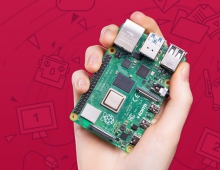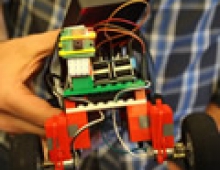
Raspberry Pi Ro Introduce New Compute Module For Industrial Use
Raspberry Pi will soon find its way to new
products and devices, in the form of the new Raspberry Pi
Compute Module -- Raspberry Pi shrunk down to fit on a SODIMM
with onboard memory.
The new compute module contains the guts of a Raspberry Pi (the BCM2835 processor and 512Mbyte of RAM) as well as a 4Gbyte eMMC Flash device (which is the equivalent of the SD card in the Pi). This is all integrated on to a small 67.6x30mm board which fits into a standard DDR2 SODIMM connector (the same type of connector as used for laptop memory). The Flash memory is connected directly to the processor on the board, but the remaining processor interfaces are available to the user via the connector pins. You get the full flexibility of the BCM2835 SoC (which means that many more GPIOs and interfaces are available as compared to the Raspberry Pi), and designing the module into a custom system should be relatively straightforward as all the tricky bits are onto the module itself.

The Compute Module is primarily designed for those who are going to create their own PCB. However, a "Compute Module IO Board" will also be available to help designers get started.
The Compute Module IO Board is an open-source breakout board that you can plug a Compute Module into. It provides the necessary power to the module, and gives you the ability to program the module?s Flash memory, access the processor interfaces in a slightly more friendly fashion (pin headers and flexi connectors, much like the Pi) and provides the necessary HDMI and USB connectors so that you have an entire system that can boot the OS of your choice. This board provides both a starting template for those who want to design with the Compute Module, and a quick way to start experimenting with the hardware and building and testing a system before going to the expense of fabricating a custom board.

Initially, the Compute Module and IO Board will be available to buy together as the Raspberry Pi Compute Module Development Kit.
These kits will be available from RS and element14 some time in June. Shortly after that the Compute Module will be available to buy separately, with a unit cost of around $30 in batches of 100; you will also be able to buy them individually, but the price will be slightly higher.

The Compute Module is primarily designed for those who are going to create their own PCB. However, a "Compute Module IO Board" will also be available to help designers get started.
The Compute Module IO Board is an open-source breakout board that you can plug a Compute Module into. It provides the necessary power to the module, and gives you the ability to program the module?s Flash memory, access the processor interfaces in a slightly more friendly fashion (pin headers and flexi connectors, much like the Pi) and provides the necessary HDMI and USB connectors so that you have an entire system that can boot the OS of your choice. This board provides both a starting template for those who want to design with the Compute Module, and a quick way to start experimenting with the hardware and building and testing a system before going to the expense of fabricating a custom board.

Initially, the Compute Module and IO Board will be available to buy together as the Raspberry Pi Compute Module Development Kit.
These kits will be available from RS and element14 some time in June. Shortly after that the Compute Module will be available to buy separately, with a unit cost of around $30 in batches of 100; you will also be able to buy them individually, but the price will be slightly higher.




















